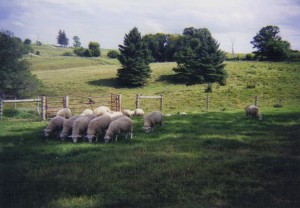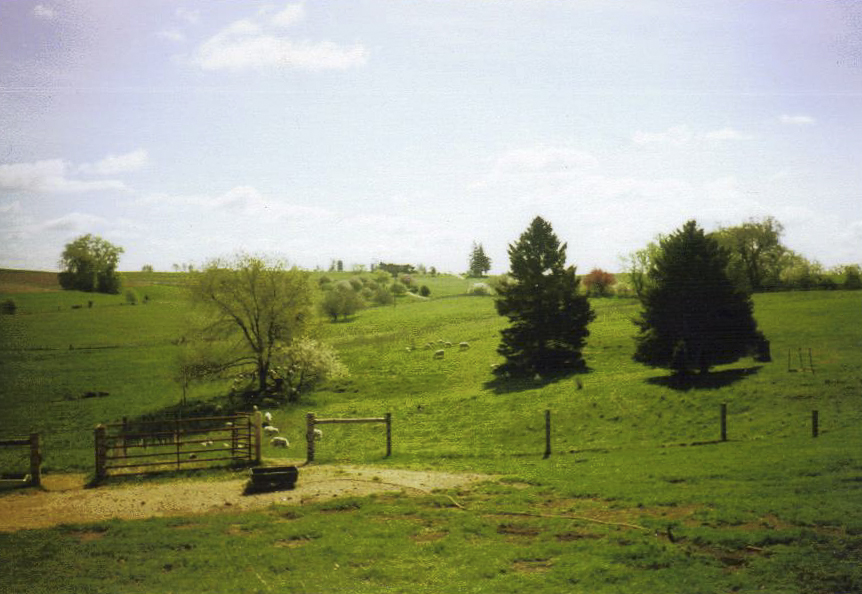1995 – Early February
No sooner had I advertised my bred ewe lambs, than a local veterinarian, who also raised sheep, came to look them over. He was interested in lambing them out this spring, then in the fall implanting them with Texel embryos. He needed disease free ewe lambs, and knew that I had kept a “closed flock” for some years now, so he was very interested in these bred ewe lambs. However, he needed to check the mothers of these lambs for OPP, (Ovine Progressive Pneumonia), a disease which was present in many flocks at that time. He came and took blood samples of all the mothers of ewe lambs, and ran tests. They all turned out OPP Negative, so that was fine.
I had however, purchased the Texel ram lamb the previous fall, which ended my closed flock status, and had also sold 4-H lambs which were shown at the county fair, thereby being exposed to sheep from other flocks, and later in the fall brought back to our farm for breeding. The vet did not think this was anything to worry about. We were scheduled to shear our sheep on Feb. 18, so he decided to leave the ewe lambs here until they were shorn.
Feb. 18: After the usual busy day of shearing a total of 115 sheep, we were ready to call it a day, when a ewe lamb suddenly aborted. I did not think too much of this, as occasionally a ewe lamb will abort, and I laid it to shearing stress, crowding, handling, etc. However, the following day another ewe lamb was aborting, so we sent specimens of placentas, fetuses, and also blood samples from several ewe lambs to the University of Minnesota Lab. While we waited for the results, one more ewe lamb aborted.
The Lab results came back, “Chlamydia enzootic abortion”, which meant the sale of the ewe lambs was off as the vet also had a flock of sheep which, like mine, were not vaccinated for Chlamydia, and bringing in sheep that are carrying it would expose that flock to the disease.

Next, we special ordered Chlamydia vaccine in order to vaccinate all the bred ewe lambs, so hopefully any that were not already infected would be protected. It took about a week for the vaccine to arrive, and during that time 2 more abortions occurred, and 3 more aborted following vaccination. It was a harrowing time!
We did not vaccinate the the mature ewe flock, as their pregnancies were too far advanced for vaccination to help. However, they had been maintained separately from the young ewes, so we were hopeful they would be okay.
All the aborted ewe lambs had to be penned separately, so they were moved to the granary, the mature group in the upper barn, the vaccinated ewe lambs in the lower barn, along with the rams, carrying hay, water, and bedding to all these groups was a bit much to handle, but it had to be gotten through!
March 19: The mature ewes began lambing. I had lived in dread of an abortion storm going through the older ewes, but by March 28 things were going well, and so far 23 ewes had produced 47 viable lambs, so all was not lost!
April 2: Bedlam! All the lambing jugs were full! I was behind with feeding, and way behind with shots, ear tagging, tails, and testicles… not to mention “clip and dip” (navel cords), and “strip” (teats), and paint branding mothers and babies… when 7 more ewes lambed non-stop, producing 6 sets of twins, and a set of triplets!
To add to the carnage, a couple MLS (miserable lamb stealers) were in operation. These are ewes whose lambing is imminent, but they just can’t wait for it to happen, so they are out to steal away any other newborns they can! Usually, while a ewe is cleaning her just dropped 2nd born lamb, the MLS will move in and start muttering to the first born lamb… probably something like, “Come with me little one, I will take you to the green pastures…” Sometimes they will even push in and start cleaning a newly dropped lamb, while the actual mother is trying frantically to cope, but to no avail, unless you are there to quickly put a pen around the real mother and lamb (s).
But with all the lambing jugs full there are no pens available, so it usually comes down to turning out another quite young family in order to use their pen to thwart the MLS! Life on the “funny farm!” You don’t have to be nuts, but it helps!
When the mature ewes’ lambing was complete, we had 104 live lambs, 2 had been lost due to lambing trauma, but it had been a very successful lambing, despite all the pitfalls along the way. It still remained to be seen how the ewe lambs, who were about to start lambing, would fare.

April 8: Lambing commenced for the ewe lambs… 19 of the 48 had aborted. We hoped that the remaining 29, who had been vaccinated would produce viable lambs, but we knew those hopes were pretty doubtful.
It was a traumatic lambing, to say the least. Two ewes were open and the remaining 27 had 20 viable lambs. The other 7 either had stillborn lambs or weak lambs that did not survive for any length of time. So, it was not what you could call a “happy lambing,” but despite being a depressing experience, we did have 20 survivors, so it was worth the struggle!
During the winter, before lambing, I had started a management intensive grazing circle in Houston and Fillmore Counties, and we held the first “House Meeting” at our place with 10 families represented. At the second meeting a couple weeks later, we had 20 families registering, and more calling all the time. In May we will start having pasture walks at various farms through October. This is an off-shoot of the Southeast Minnesota Sustainable Farming group, of which I am a member.
The Land Stewardship Project is also busy, and I am on a committee, along with about a dozen others, working on accessing credit for beginning farmers, sustainable farmers, and those who are restructuring. More on this in a future story!



How sad about your ewe lambs and their infection. How does that spread among lambs? Did you have to keep them separate to keep it from spreading? All the work of farming and then to throw contagious illness into the mix! It must have been very sad to loose all those babies. I was also thinking you need an assembly line at lambing time to take care of vaccinations, tails, teats, testicles, tagging and more. Do other farmers come and help out at lambing time or does everyone’s lambs all go into labor about the same time? I am learning so very much from you.
Yes Sands, that was a sad and depressing time, it was even hard to write about so many years later.
We did not know where the chlamydia infection came from, which made it all the worse. We did strongly suspect that it originated with the Texel ram lamb we purchased the previous year, who had bred all these ewe lambs. Of course we contacted the breeder we had purchased him from, but he had not had any incidence of chlamlydia, so that led nowhere.
The only other possible sources were the 4-H lambs we had sold the previous year, and had later in the fall brought them back to be bred along with our ewe lambs. That still seemed very unlikely, so the young ram was still the strongest suspect. What to do? Get rid of him, or use him again and take the chance? No easy answers!
There was very little help available at lambing time, as most people who were knowledgeable about lambing were busy with their own flock, or lived too far away. I did have two friends who helped me out a couple times, one was Jeananne who was my co-chair on the lamb promotion committee. She had sheep, so was experienced, and was also a RN, another plus.
At the time she came to help out with lambing, she no longer had sheep, and missed them, so it was fun for her to get her back in the game, and she came and stayed for about two weeks, and we had a delightful time! I even managed to get a little sleep, an almost non-existent commodity at lambing time!
Thanks for your comments!